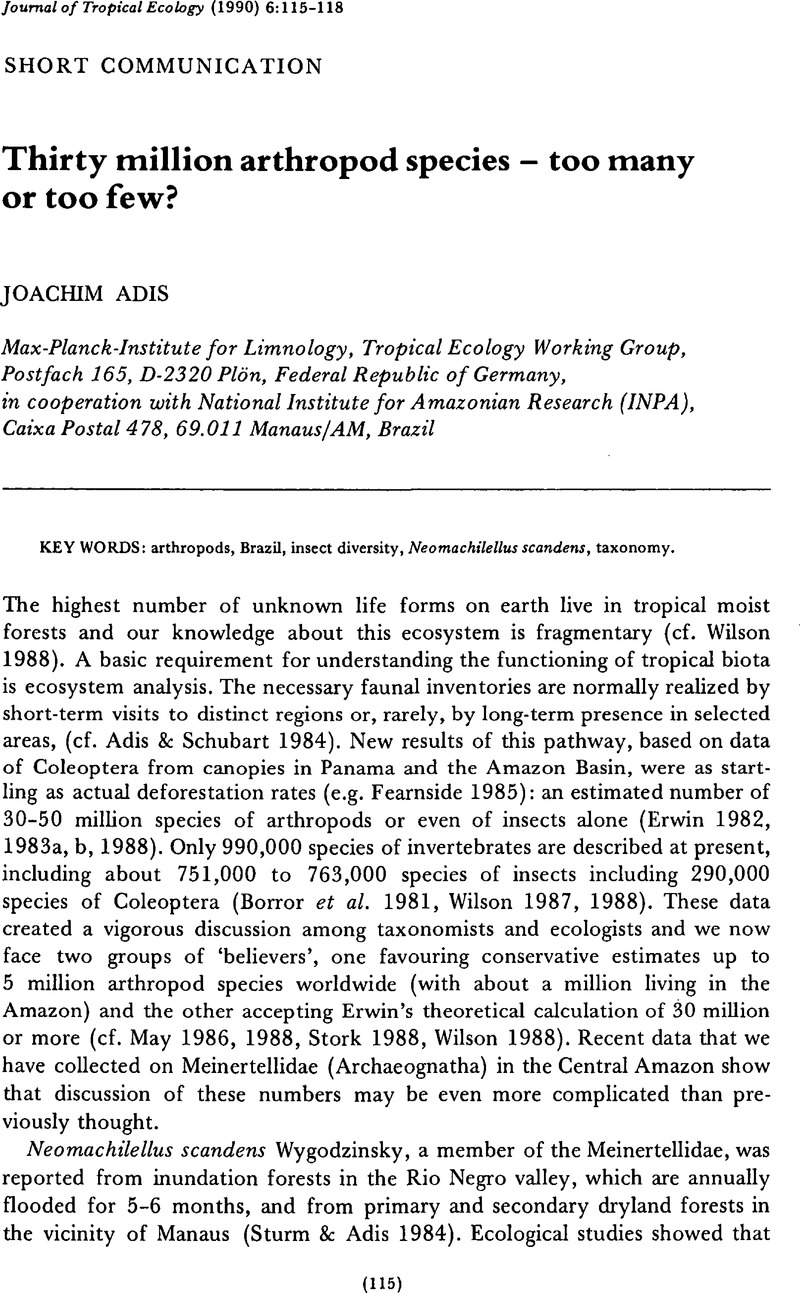Crossref Citations
This article has been cited by the following publications. This list is generated based on data provided by Crossref.
Myers, Norman
1990.
The biodiversity challenge: Expanded hot-spots analysis.
The Environmentalist,
Vol. 10,
Issue. 4,
p.
243.
1990.
How many species?.
Philosophical Transactions of the Royal Society of London. Series B: Biological Sciences,
Vol. 330,
Issue. 1257,
p.
293.
Müller‐Motzfeld, Gerd
1991.
Artenschwund und Artenschutz bei Insekten.
Mitteilungen aus dem Museum für Naturkunde in Berlin. Zoologisches Museum und Institut für Spezielle Zoologie (Berlin),
Vol. 67,
Issue. 1,
p.
195.
ERWIN, TERRY L.
1991.
How Many Species Are There?: Revisited.
Conservation Biology,
Vol. 5,
Issue. 3,
p.
330.
Gaston, Kevin J.
1991.
The Magnitude of Global Insect Species Richness.
Conservation Biology,
Vol. 5,
Issue. 3,
p.
283.
Paoletti, M.G.
Pimentel, D.
Stinner, B.R.
and
Stinner, D.
1992.
Biotic Diversity in Agroecosystems.
p.
3.
Paoletti, M.G.
Pimentel, D.
Stinner, B.R.
and
Stinner, D.
1992.
Agroecosystem biodiversity: matching production and conservation biology.
Agriculture, Ecosystems & Environment,
Vol. 40,
Issue. 1-4,
p.
3.
Walker, Ilse
1992.
Life history traits of shrimps (Decapoda: Palaemonidae) of Amazonian inland waters and their Phylogenetic interpretation.
Studies on Neotropical Fauna and Environment,
Vol. 27,
Issue. 2-3,
p.
131.
Myers, Norman
1993.
Questions of mass extinction.
Biodiversity and Conservation,
Vol. 2,
Issue. 1,
p.
2.
Kim, Ke Chung
1993.
Biodiversity, conservation and inventory: why insects matter.
Biodiversity and Conservation,
Vol. 2,
Issue. 3,
p.
191.
Stork, Nigel E.
1993.
How many species are there?.
Biodiversity and Conservation,
Vol. 2,
Issue. 3,
p.
215.
Price, Trevor
1996.
Exploding species.
Trends in Ecology & Evolution,
Vol. 11,
Issue. 8,
p.
314.
Osler, Graham H. R.
and
Beattie, Andrew J.
2001.
Contribution of oribatid and mesostigmatid soil mites in ecologically based estimates of global species richness.
Austral Ecology,
Vol. 26,
Issue. 1,
p.
70.
Osler, Graham H. R.
and
Beattie, Andrew J.
2001.
Contribution of oribatid and mesostigmatid soil mites in ecologically based estimates of global species richness.
Austral Ecology,
Vol. 26,
Issue. 1,
p.
70.
Osler, Graham H. R.
and
Beattie, Andrew J.
2001.
Contribution of oribatid and mesostigmatid soil mites in ecologically based estimates of global species richness.
Austral Ecology,
Vol. 26,
Issue. 1,
p.
70.
Wantzen, K. M.
Wagner, R.
Suetfeld, R.
and
Junk, W. J.
2002.
How do plant-herbivore interactions of trees influence coarse detritus processing by shredders in aquatic ecosystems of different latitudes?.
SIL Proceedings, 1922-2010,
Vol. 28,
Issue. 2,
p.
815.
Moyle, Brendan J.
2006.
Optimal Wildlife Research: An Introduction.
SSRN Electronic Journal,
Schipper, Aafke M.
Lotterman, Kim
Geertsma, Marten
Leuven, Rob S. E. W.
and
Hendriks, A. Jan
2010.
Using datasets of different taxonomic detail to assess the influence of floodplain characteristics on terrestrial arthropod assemblages.
Biodiversity and Conservation,
Vol. 19,
Issue. 7,
p.
2087.
Macías-Ordóñez,, Rogelio
Machado, Glauco
and
Macedo, Regina H.
2013.
Sexual Selection.
p.
1.
Rasmann, Sergio
Alvarez, Nadir
and
Pellissier, Loïc
2014.
Annual Plant Reviews.
p.
339.





